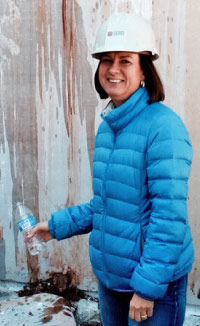Consolidation in the Stone Industry
Slippery Rock Staff
If you’ve kept reasonably informed over the last few years, you’ve no doubt seen some big changes in our industry. With mouthwatering new sources of stone, equipment that could only be imagined a few decades ago, and new designs and uses for what we produce, there’s never a dull moment in our ever-evolving industry. But it is acquisitions and consolidation, some behind the scenes by industry movers and shakers, that’s the focus of this story.
Considerations for a merger or acquisition from the buyer include the efficiency and age of the company or management. Does the founder or founders not have someone to pass the company to, or an exit plan? Have they been innovative or not, are they weak on the marketing side, or do they not have the energy or vision to continue? In this instance, two companies with each having different advantages could make great partners. In conclusion, it’s these and other reasons that are driving this consolidation as told from the perspective of three industry luminaries with decades of experience in the stone industry.
First, representing Big Fish Consulting and The Artisan Group is Jon Lancto. John was a fabrication shop-owner for 27 years, and is the current owner of Big Fish Consulting located in Charleston, South Carolina. Jon is the President of The Artisan Group, a national network of premium stone fabricators.
Second, representing Tennessee Marble Company, is Monica Gawet. Monica entered her family’s stone fabrication business in 1993. Soon after, the family purchased the Tennessee Marble Company located in Friendsville, Tennessee where she has since been the President.
Third, representing Premier Surfaces-Northeast, a fabricator located in Rochester, New York, is Gregg Sadwick. Gregg has directed the company as President since the company was acquired a few years ago, and is now part of a conglomerate serving the eastern half of America.
 |
|
Jon Lancto, Artisan Group |
Jon Lancto: “The driving force of the consolidation in our industry is by people with private equity looking for places to put their money. The stone industry in the past, because of its newness in the world and until the advent of diamond tooling to cut granite, in comparison to other types of companies, was very small. It was this diamond tooling that was the impetus to jump-starting the countertop industry, and once it got rolling along, it was mostly by craftsman without a business background, and the skills to think in terms of consolidating or merging with other companies.
“But as things went along, we got a new crop of managers coming into these businesses who had more of a business background, and opened up the door for the acquisition phase that we are going through right now. Mostly what’s driving this is the aging-out of the original people who started these companies. They are getting to a point in their lives where they are not going to pass the company on to family members, and need some sort of an exit strategy. Additional reasons for acquisitions are influenced by capital shortages, trying to comply with new safety regulations (such as OSHA), or don’t have what it takes to buy high tech equipment that’s now required to be profitable.
So, it’s really a mix of things that are influencing this consolidation.”
Jon continued, “There’s also the dynamics of consolidations in the distribution business. I’ve seen this playing out, too, especially with companies that are distributing engineered materials where they need a major brand to be successful. Companies that have their own brand or private label, that are not getting national distribution, are going to have a harder time of marketing their products to compete against major brand names that have distribution facilities across the United States. So the industries’ transition to engineered materials is affecting and accelerating the rates of roll-up within these distribution businesses as well.
“So are acquisitions good or bad? Well... they are good for companies that are not reaching their full potential and the employees are at sort of a dead end, and when you have somebody that’s willing to come in and inject capital and modernize the facility and get it up to higher standards, it provides a longer career path for those employees. The other positive is that if someone needs an exit strategy and are positioned to sell, they need someone to come in and buy. Some acquisitions are done very well with good people at the top who enjoy working with these companies, but there are some situations where it hasn’t been a good thing, because the management wasn’t there to take on multi-branch locations and make them successful. So there have been failures and successes in all of these situations.
“As for the future, I think we will continue to see consolidations. I know just from conversations with The Artisan Group members I work with that there are several members looking for these types of opportunities that will take their companies to a different level. I also think that consolidation in our industry will continue to play out, because the money that’s sitting on the sidelines looking for these types of opportunities is still there. The stone industry is young and ripe for roll-ups, and we need to see it stay at this current level and not faster.
 |
|
Monica Gawet, Tennessee |
Monica Gawet: “I see acquisitions as simply a byproduct of what’s happening in the stone industry and neither good nor bad. There are people who want their companies to get bigger or they see opportunities for consolidation and being more efficient in the market, and have the capital to invest. I think that the most important things to look at in an acquisition, though, is whether or not the accessibility of the acquired company’s stone will be the same or greater.
“When I came to Tennessee Marble Company in the ‘90s, it wasn’t a great time in the market place and with not anywhere near as many fabricators who were small or medium, and are now larger. Today, the industry has expanded in all those levels. This is a good thing. What I do worry about, however, is that there are so many companies selling the engineered materials along with natural stone. That, to me, is more worrisome, only because I am a natural stone quarry and fabricator, period! Sometimes I see customers, be it architect or residential, walk into a fabrication shop and say, ‘Oh, wow! I like this! How much does it cost?’ and base so much of their decision on a low price. I understand fully that shops want to offer variety, but as a player in natural stone, I don’t see it as a good thing and far more dangerous to our industry than acquisitions. For the consumer, though, all these choices are fantastic, right? More choices than ever before with different price points, colors and durability, but that’s different than the question of the industry and how we react to that.
“I don’t have my finger on the pulse of small shops. That said, it is not inexpensive to start a shop if you want to just do very simple things with simple edges. But these days, people want different finishes and details that are far more elaborate than years ago, and you need more sophisticated equipment that is very expensive. So shops that get bigger and more sophisticated are a natural progression that is driven by a plethora of different options that are out there, and in some ways the consumer knows it, because they can go on websites that show different products that create different expectations. Years ago, simply having different types of marble and granite was enough, and if you were looking for something specific, you just called a shop to find what you were looking for. But these days, shops have a lot of pressure on them to offer a lot of different products. So as a shop owner, if you find yourself not being competitive, you might have to find yourself a partner.
“In terms of some of the larger consolidations, I hope I’m seeing them make a difference in the viability and the life span of quarries. This to me is number one, because if you look at American history, an incredible amount of quarries were not able to survive.
My conclusion has always been that they didn’t invest in new technology and didn’t take capital and reinvest it into their company. “These days, with larger consolidations, there is a great focus on efficiency and the expansion and the availability of North American stone, and to me there is nothing better than this for American quarry operators.
“In closing, as an industry, we should constantly be asking ourselves what are we doing well and what are we not doing well. I think right now we are on very good footing to continue to hold our ground for the use of natural stone and can expand on it. I say that because there is a tremendous amount of production capability and capacity in America. What concerns me, however, is that there are so many alternates to natural stone, and that is the big threat to us. We have to find ways to be competitive and differentiate, because our stuff is going to cost more than the man- made stuff, and the buyer needs to see the benefits of that higher cost. Natural stone has sustainability and aesthetic advantages, and is very friendly to the environment. If these benefits can be taken advantage of, I think that we will be able to increase our market share.”
 |
|
Gregg Sadwick, Premier Surfaces |
Gregg Sadwick: “In the context of companies, there is the supply side and the demand side. On the supply side, I think you have a lot of fabricators, such as our company, that were started 35 or so years ago. They are wonderful companies that now need an exit strategy that they did not plan for. On the demand side, there’s a lot of money on the sidelines and people that are looking to put that money into any industry that looks appealing. So, it is an interesting time for the cross sections of supply and demand. You have people who want to get out, and people who have the money to get in. This is one of the bigger driving factors, and when an investment company starts looking at companies, some of these owners are more ready to sell, and all of a sudden are thinking, ‘Oh, gee whiz, I gotta do something. I don’t want to be the odd man out because I didn’t get out when I should have.’
“So, I think that this excitement, if you will, has also precipitated some of that. Do I think that these mergers and acquisitions are a good thing? Yes! I think it’s healthy and good for the market, and very similar to what we are doing at Premier Surfaces Northeast where we are collectively figuring out ways to do better, and that’s good for the market. Solid competition should be lowering prices, and that’s going to lower our costs, and we will be more affective.
“As for how it affects the employees, when you’re buying a company; the team has to be intact, and if it isn’t, what are you really buying? What you are really buying is all those intangibles that come with the people, not the equipment, and if you are just buying the equipment, you might as well do a startup.
“I also get the part of negative attitudes by employees, but when I came to this company, one of the first things I told them was that nobody has to worry about losing their job other than me! If we are not performing, they are not going to shut this place down. They are going to get someone else who knows how to run the darn thing, and that’s the truth! So a lot depends on who is coming in and how they handle it. The people here knew I was a local guy and not just some plant by corporate. I also think it generally helps the employees and provides them more opportunity. This cross pollinating of companies allows people, who have seen only one way of doing things for many years, the ability to see that there is another way of doing things, and this collaboration improves their skills.
“So you lose the family atmosphere of the company? Well... In our instance, we’ve kept the leadership local in all divisions. We are not answering to an unknown face five states away. We have to keep a local presence, because our customers are all relationship-based, and we need to maintain those relationships at a local level and not distant. Those customers still want to know that they still have access to a local leader.
“One other advantage to private equity coming in to mergers and acquisitions, in our case, is that the seller of our company had what he needed, but may not have been as aggressive as private equity tends to be. What he had done in the first 35 years may have worked very well, but as the market was changing, he didn’t want to deal with it, because he had been there and done that and could have been an inhibiting factor. I’m not saying that it was, but there’s the potential for this to occur, and in private equity we don’t have that luxury. We have to continue to grow the business for everyone and provide opportunities.
“As for the future of acquisitions in the stone industry, I see it growing. I think that the advantages we are seeing with our team make it so much stronger at the local level. I see that as the technology changes and as more OSHA rules come out, it’s going to be tougher for the smaller guy to succeed. Additionally, customers’ expectations are changing. Everyone wants better and better service. Some of the things that we are doing here with the Premier Surfaces team are developing technology tools that make our information flow better from templating to installation, and smaller players don’t have the ability or capital to do that. Also, the new tools and equipment that are coming out are going to be expensive for some of these smaller players, but with a private equity group behind them that’s willing to throw in capital, we are going to see more of it, to be frank.”
So, is consolidation in the stone industry good or bad? Well... you’ve heard the opinions. You be the judge. What all our industry veterans agree on is that you better have top-flight service to go with increased size and capability.